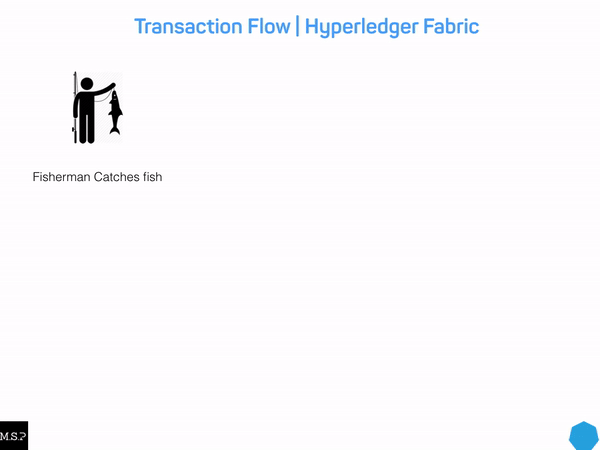What is Hyperledger?
Hyperledger is the umbrella open source project that the Linux Foundation has created and hosted since 2015. It aims at advancing and promoting cross-industry blockchain technologies to ensure accountability, transparency, and trust among business partners. As a result, Hyperledger makes business network and transactions more efficient.
Difference between Distributed Ledger & Blockchain
The most important difference to remember is that blockchain is just one type of distributed ledger. Although blockchain is a sequence of blocks distributed ledgers do not require such a chain. Furthermore, distributed ledgers do not need proof of work and offer theoretically – better scaling options

Components of Hyperledger Frameworks
Hyperledger business blockchain frameworks are used to build enterprise blockchains for a consortium of organizations. They are different than public ledgers like the Bitcoin blockchain and Ethereum. The Hyperledger frameworks include:
-
An append-only distributed ledger
-
A consensus algorithm for agreeing to changes in the ledger
-
Privacy of transactions through permissioned access
-
Smart contracts to process transaction requests.

Technical Dependencies
Install cURL
$ sudo apt install curl
cURL is a tool to transfer data from or to a server, using one of the supported protocols. The name is a play on ‘Client for URLs’, originally with URL spelled in uppercase to make it obvious it deals with URLs.
Docker
docker --version && docker-compose --version
Docker is a tool designed to make it easier to create, deploy, and run applications by using containers. Containers allow a developer to package up an application with all of the parts it needs, such as libraries and other dependencies, and ship it all out as one package. The isolation and security allow you to run many containers simultaneously on a given host. You can even run Docker containers within host machines that are actually virtual machines!


Node.js & npm
node — version && npm — version
What is Node.js?
-
Node.js is an open source server environment
-
Node.js is free
-
Node.js runs on various platforms (Windows, Linux, Unix, Mac OS X, etc.)
-
Node.js uses JavaScript on the server
What is npm?
-
NPM is a package manager for Node.js packages, or modules if you like.
-
www.npmjs.com hosts thousands of free packages to download and use.
-
The NPM program is installed on your computer when you install Node.js
-
NPM is already ready to run on your computer!
GO
Go is an open source programming language that makes it easy to build simple, reliable, and efficient software. Go is created at Google in 2009 by Robert Griesemer, Rob Pike, and Ken Thompson.

Tuna Fishing Supplychain
Problem Context:
our goal is to eliminate illegal, unreported, and unregulated fishing. We will use Hyperledger Fabric to bring transparency and clarity to a real-world example: the supply chain of tuna fishing.
We will be describing how tuna fishing can be improved, starting from the source, fisherman Sarah, and the process by which her tuna ends up at Miriam’s restaurant. In between, we’ll have other parties involved, such as the regulator who verify the validity of the data and the sustainability of the tuna catches.

What is Hyperledger Fabric Chaincode ?
In Hyperledger Fabric, chaincode is the ‘smart contract’ that runs on the peers and creates transactions. More broadly, it enables users to create transactions in the Hyperledger Fabric network’s shared ledger and update the world state of the assets.
Chaincode is programmable code, written in Go, and instantiated on a channel. Developers use chaincode to develop business contracts, asset definitions, and collectively-manage decentralized applications. The chaincode manages the ledger state through transactions invoked by applications. Assets are created and updated by a specific chaincode, and cannot be accessed by another chaincode.
Applications interact with the blockchain ledger through the chaincode. Therefore, the chaincode needs to be installed on every peer that will endorse a transaction and instantiated on the channel.

Quick High Level Overview:
Peer can be part of one or more channel
Every channel has a separate ledger
Every Channel has one or more chain codes
Every Chain code has a different endorsement policy
Chaincode must be part of a channel. As the ledger is part of a channel. One channel can have as many chaincodes as possible.
Chaincode must be installed in each peer that is part of the channel and instantiated.
When a Chaincode gets instantiated a policy (endorsing) has to be defined. [consensus: before a transaction can be recorded in the ledger only if a rule is met]
Stakeholders
-
Sarah is the fisherman who sustainably and legally catches tuna.
-
Regulators verify that the tuna has been legally and sustainably caught.
-
Miriam is a restaurant owner who will serve as the end user, in this situation.
-
Carl is another restaurant owner fisherman Sarah can sell tuna to.



Here are the four example attributes of tuna fish that we will be recording on the ledger:
-
Vessel (string)
-
Location (string)
-
Date and Time (datetime)
-
Holder (string)
We create a Tuna Structure that has four properties. Structure tags are used by the encoding/json library
type Tuna struct {
Vessel string ‘json:”vessel”’
Datetime string ‘json:”datetime”’
Location string ‘json:”location”’
Holder string ‘json:”holder”’
}
Chain Code: Invoke Method
As described earlier, the Invoke method is the one which gets called when a transaction is proposed by a client application. Within this method, we have three different types of transactions — recordTuna, queryTuna, and changeTunaHolder, which we will look at a little later.
As a reminder, Sarah, the fisherman, will invoke the recordTuna when she catches each tuna.

Change TunaHolder can be invoked by Miriam, the restaurateur, when she confirms receiving and passing on a particular tuna fish as it passes through the supply chain. queryTuna can be invoked by Miriam, the restaurateur, to view the state of a particular tuna.

Regulators will invoke queryTuna and queryAllTuna based on their need to verify and check for sustainability of the supply chain



